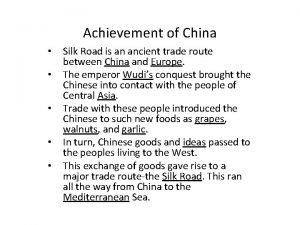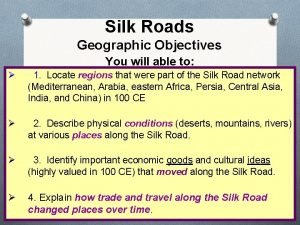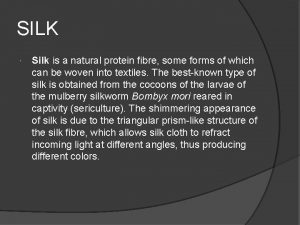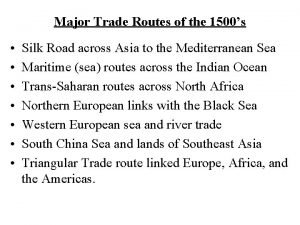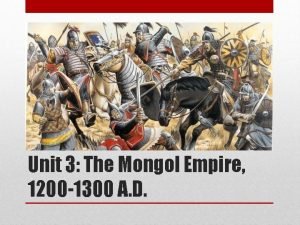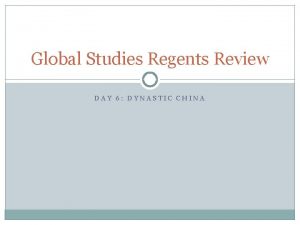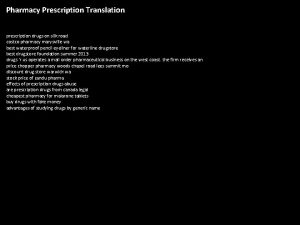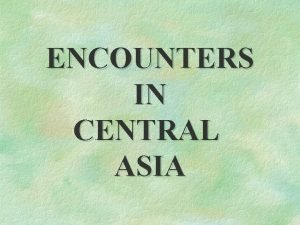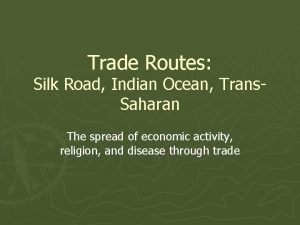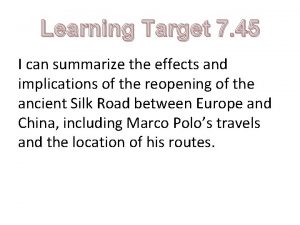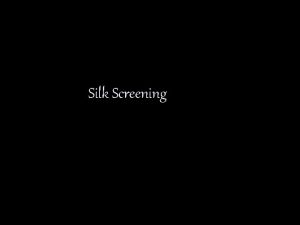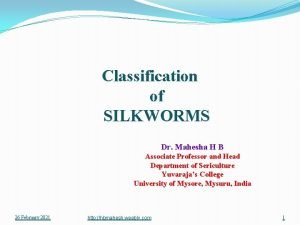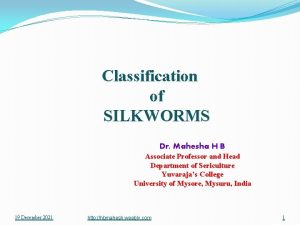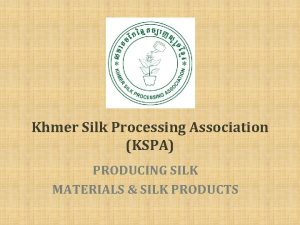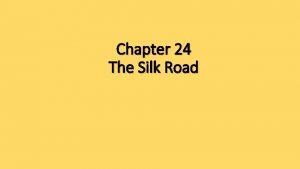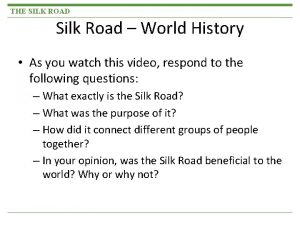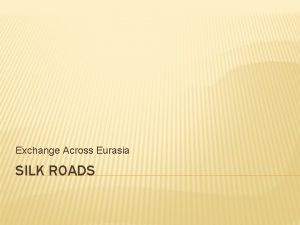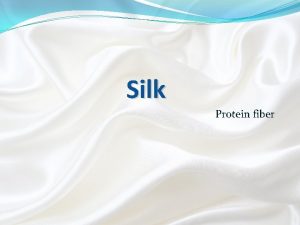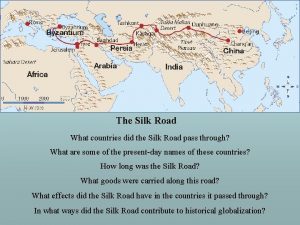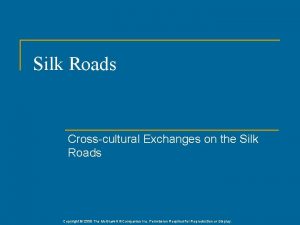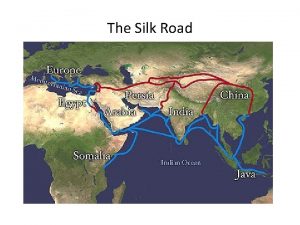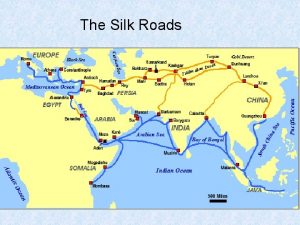People make silk from the cocoons of silkworms





























- Slides: 29


People make silk from the cocoons of silkworms. Have you ever seen a butterfly cocoon?

It is just like that.

You have to take zillions of these cocoons and unwind them carefully,

and that makes long threads like spider webs, and you spin these together to make them thicker,

and then weave them to make silk.

Silkworms will only eat fresh mulberry leaves, and for a long time mulberry trees only grew in China and Japan (and East Asia generally)

and so all silk that people had in India or West Asia or Africa or in the Mediterranean or Europe had to be brought from East Asia.

Traders probably began to bring silk from East Asia to India and West Asia around 2000 BC.

By the time of the Roman and Parthian Empires, silk was very popular in West Asia and around the Mediterranean and a lot of silk was being imported.

Because it had to come from so far away, silk was very expensive. Ordinary people could not afford to wear silk. But everyone wanted to wear silk.

It was very pretty, smooth and shiny and soft, and comfortable to wear. Also it was cooler in the summertime than wool or linen.

China guarded the secret of silk production tightly, but engaged in extensive trade in silk fabrics along the famous 6, 000 -mile Silk Road.

This “road” took the form of a caravan tract winding its way through scorching deserts and over treacherous mountains until it finally reached the Mediterranean Sea. The “road” then became a waterway as silk was shipped to Greece and Rome.

Around 600 AD, some Christian monks who had gone to China managed to smuggle out two baby mulberry trees and some silkworms under their tunics, and brought them back to West Asia.

Soon these silkworms were making silk in Syria, and silk became a lot cheaper than it had been before.

When the Islamic Empire took over Syria less than a hundred years later, it also took over the silk business.

Because of this, silk was generally much cheaper and more available in the Islamic Empire than it was in medieval Europe.

By the 13 th century, however, Italy had gained dominance in silk history. Venetian merchants traded extensively in silk and encouraged silk growers to settle in Italy.

Even now, silk processed (finished, dyed, printed) in the province of Como enjoys an esteemed reputation.

Italian silk was so popular in Europe that Francis I of France invited Italian silkmakers to France to create a French silk industry, especially in Lyon.

By the 17 th century France was challenging Italy's leadership, and the silk looms established in the Lyons area at that time are still famous today for the unique beauty of their weaving.

The nineteenth century and industrialization saw the downfall of the European silk industry.

Cheaper Japanese silk, especially driven by the opening of the Suez Canal, was one of the many factors driving the trend.

China gradually re-captured her position as the world's biggest producer and exporter of raw silk and silk yarn – proving that the history of silk follows its own boomerang principles.

Today, around 125, 000 metric tons of silk is produced in the world. Almost two thirds of that production takes place in China.

The other major producers are India, Japan, Korea, Thailand, Vietnam, Uzbekistan, and Brazil.

In December 2006 the General Assembly of the United Nations proclaimed 2009 to be the International Year of Natural Fibres, so as to raise the profile of silk and other natural fibres

Sources nwww. texeresilk. com nwww. historyforkids. org nwww. silk-road. com nen. wikipedia. org nwww. historyofsilk. com nwww. wovenhistory. com nwww. squidoo. com
 Silk road achievements
Silk road achievements Passiivi ja aktiivi englanti
Passiivi ja aktiivi englanti Cadbury dairy milk
Cadbury dairy milk Say silk 5 times
Say silk 5 times Indefiniittipronominit englanti
Indefiniittipronominit englanti Dunhuang
Dunhuang Which natural polymer comes from a cocoon? rubber wool silk
Which natural polymer comes from a cocoon? rubber wool silk Trade routes 1500
Trade routes 1500 Silk background
Silk background Silk is a natural protein fiber
Silk is a natural protein fiber Spider goat silk
Spider goat silk What did the mongols do for the silk road
What did the mongols do for the silk road Kings play chess on fine green silk
Kings play chess on fine green silk Which phrase correctly describes the tang dynasty?
Which phrase correctly describes the tang dynasty? Shot silk appearance in hypermetropia
Shot silk appearance in hypermetropia Distribution of cotton woollen and silk industries map
Distribution of cotton woollen and silk industries map Silkroad pharmacy
Silkroad pharmacy Silk road map route
Silk road map route Pantaloon hernia
Pantaloon hernia Silkworm
Silkworm Wine rice indigo silk tobacco
Wine rice indigo silk tobacco How silk is produced
How silk is produced Philips ledalite
Philips ledalite Silk road indian ocean trans saharan
Silk road indian ocean trans saharan Trans saharan trade route
Trans saharan trade route Spider goat silk
Spider goat silk Female workers in japanese silk factories dbq answers
Female workers in japanese silk factories dbq answers Silk road multiple choice questions
Silk road multiple choice questions Types of hydrocele
Types of hydrocele Silk road goods traded
Silk road goods traded
